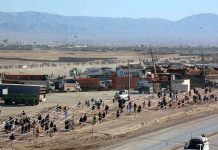
QUETTA: On any given day, 32-year-old Mohammed Akram can be found in and around the City Nullah in Quetta, walking dazed and swooning, with his head bent as he crosses the crowded streets on Jinnah Road.
Mohammed Akram lives near the storm drain known as Habib Nullah, an infamous drain in the heart of Quetta. Dozens of drug addicts, mainly heroin addicts, live in and around the open drain that runs through the city for nearly six kilometers.
Akram started using hard drugs because he found it cheap and easy at the nullah.
“I was depressed because I could not find a job despite trying hard,” said Mohammed Akram who has a matriculation certificate—ten years of high school education.
Akram now begs for money in the streets. He says the heroin is easily available at the drain storm. “We do not need to go anywhere as everything is available right here.”
There are several spots in Quetta like the Satellite Town, Saryab Road and Quetta suburbs where one can buy heroin for a couple of hundred rupees.
“The heroin addicts that frequent the nullah are mostly thieves and robbers”, a police officer Shah Mohammed told News Lens at the Bijli Road Police Station in Quetta.
According to a senior official of Anti-Narcotics Force (ANF) in Quetta, who asked to be anonymous because he was not authorized to speak to media, the ANF and police had carried out several raids and arrested dozens of heroin addicts from Habib Nullah and other areas.
“We often carry out raids and arrest those who are selling drugs”, the official told News Lens. “However, still a lot more needs to be done to completely eradicate the illicit use of drugs.”
The main reason for increasing use of illicit drugs in Pakistan, according to the United Nations Office on Drugs and Crime (UNODC), is the country’s strategic location on one of the world’s busiest drug trafficking corridors, largely due to the cultivation of opium poppy and cannabis in the neighbouring Afghanistan.
Balochistan province shares long borders with two countries—Iran and Afghanistan. “Afghanistan produces around 90 percent poppy—raw heroin of the world – and uses the Balochistan province as a route to get access to international market”, Cesar Guedes, Country Representative of UNODC, told News Lens.
In a recent report, UNODC said an estimated 40 percent of heroin and hashish produced in Afghanistan is routed through Pakistan. “This generates a considerable opiate supply for export but also for domestic use in Balochistan,” said the report.
“Afghanistan has 90 percent of the world’s poppy fields and Pakistan is drastically affected being a neighbor of war-torn country,” said Cesar Guedes. “Pakistan is not the prime destination for heroin but a considerable size of raw heroin stays in Balochistan for one reason or another, increasing the use of drugs in the province.”
UNODC’s recently launched first ever report on drug use at the provincial level reveals that at least 6.7 million people, between the ages of 15-64 years, use drugs in Pakistan. This means six percent of the population used drugs in the last 12 months.

The report further said an estimated 860,000, or 0.8 percent of the population, were regular heroin users and 320,000 (0.3 percent of the population), are opium users.
The highest prevalence of opiate users was found in Balochistan, where 1.6 percent of population used either heroin, opium, or both.
“The majority of drug users in this study fell between 25 and 39 years of age,” said in the report, “Cannabis use was highest among 30 to 34 years old and heroin use was highest among 35 to 39 years old.”
According to the report, men were found to use more drugs than women for most drug types. Women were more likely to misuse tranquilizers and sedatives as well as amphetamines. Among dependent users, women were less likely to have received treatment than men.
The report said how Pakistan’s population aged 15 to 64 suffered from the devastating consequences of substance abuse: “Although 4.25 million individuals are thought to be drug dependent, treatment and specialist interventions are in short supply, available to less than 30,000 drug users a year.”
Whatever little treatment available to rehabilitate drug abusers is not free of charge, making it unaffordable for people to seek help. “In a country where almost a quarter of the population is estimated to be living on less than US$ 1.25 a day, the barriers preventing access to structured treatment are exceptionally high.”
The UNODC head said that Afghanistan was not a stable country which was why Pakistan was being affected by the cross-border drug trade.
The Provincial Minister for Health, Rehmat Saleh Baloch, told News Lens that the government was making utmost efforts to prevent drug use in the province. He said, “Law enforcers have launched a crackdown against drug peddlers while a Model Treatment and Rehabilitation Centre for addicts has been established in Quetta.”
“The government is not ignorant,” he said. “People will see positive results soon.”



